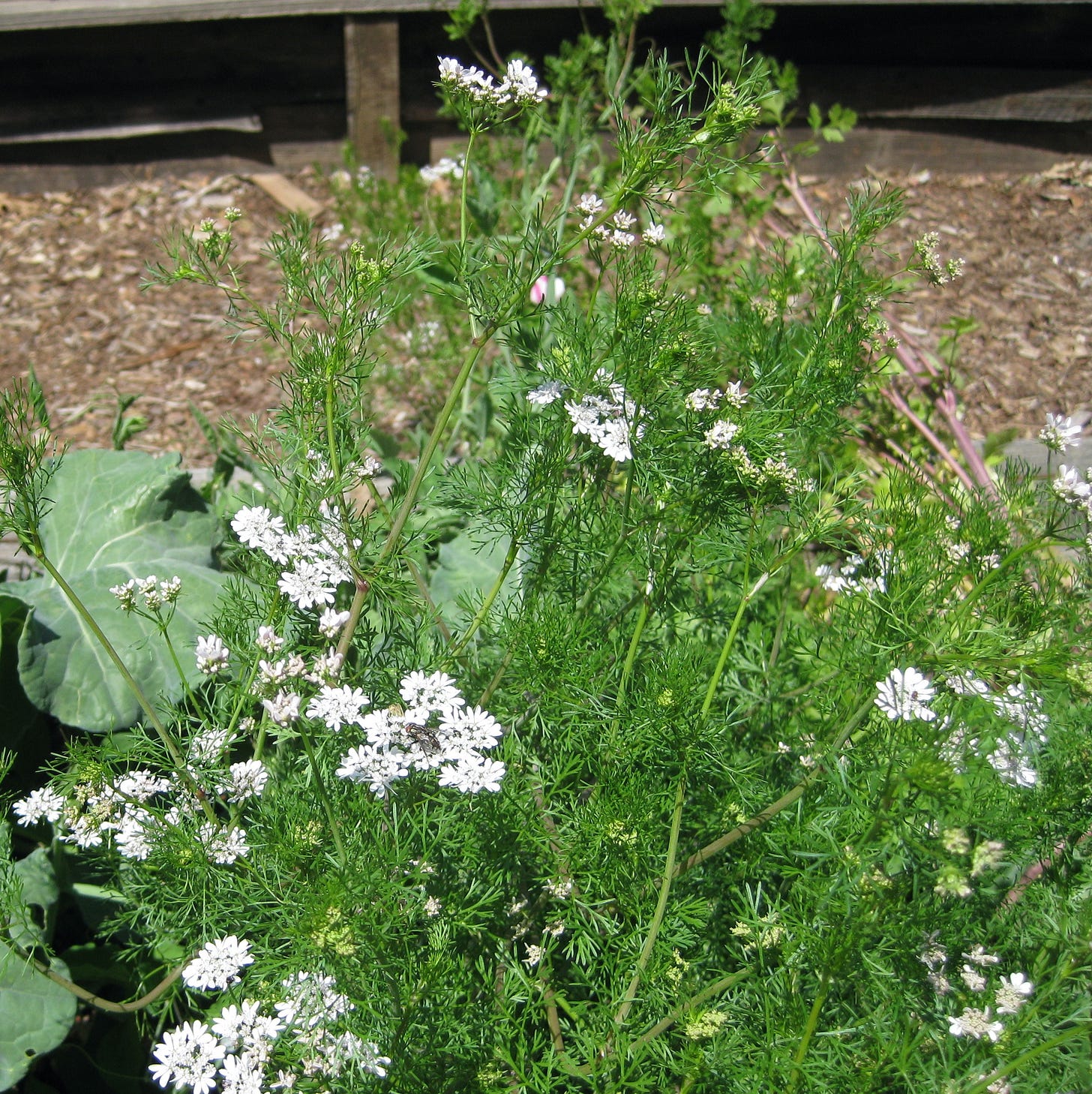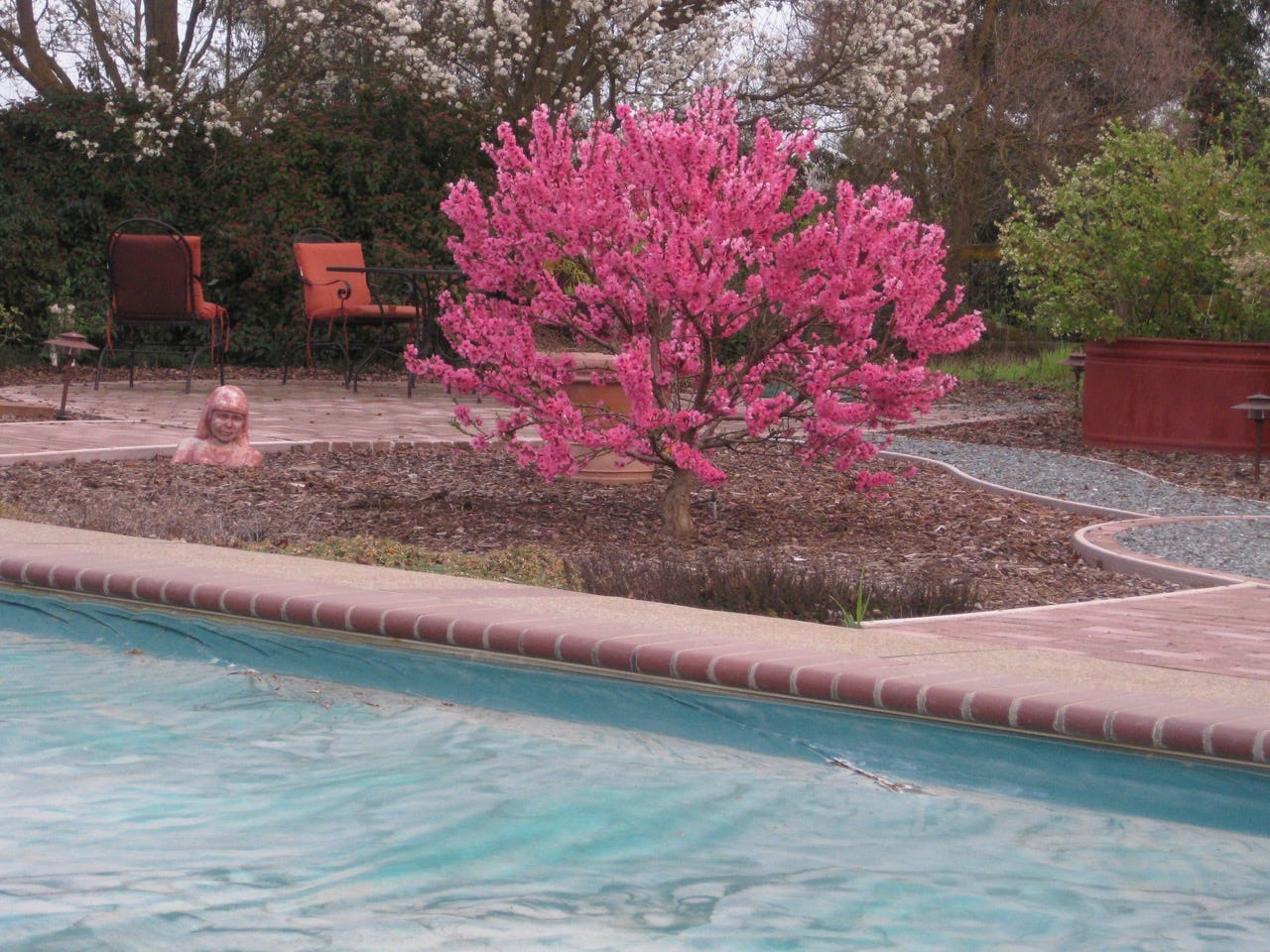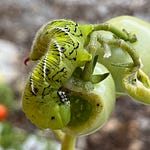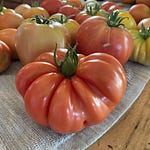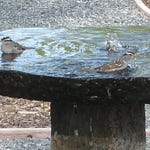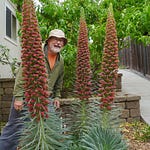Are you trying to grow a salsa garden? It's great that most of the ingredients for salsa ripen at about the same time in the backyard garden. The main salsa ingredients - tomatoes, peppers, onions, and garlic - are ready this time of year. And if you wait until September or October to make the salsa, there might be some limes ready from a backyard lime tree in citrus growing regions. But there is one ingredient that throws off that salsa recipe timing: cilantro. Cilantro is easy to grow in hot climates in fall, winter, and early spring. But in hot summers? You can forget about it being ready when the rest of your salsa ingredients are all growing fine. Because of the rising frequency of extended, triple digit summer temperatures (“heat dome” seems to be the 2024 phrase that pays), cilantro is going to turn bitter and send up flower stalks (which, by the way, the beneficial insects love).
You could buy cilantro at the store or farmer’s market. But the aroma and tangy taste of fresh, homegrown, just-picked cilantro can’t be beat.
Before we delve into the solution for getting fresh homegrown cilantro in the summer, here’s what you may have missed in last Friday’s Garden Basics with Farmer Fred Podcast, #348:
Right now - mid-summer - is peach and plum harvest time for most of us. Phil Pursel of Dave Wilson Nursery talks about choosing the tastiest peach and plum tree varieties, along with care tips, including watering and fertilization. Phil points out the difference between freestone and cling peaches, the importance of chill hours for peach trees, and the major insect pests of peach trees. Phil’s favorite peach: the Red Baron. Fred’s favorite: a dwarf variety, the Garden Gold peach. Phil’s favorite plum: the Emerald Beaut. Fred’s tastiest favorite plum: The weeping Santa Rosa plum.
We’ve talked in the past about ways to improve clay soil; but what about sandy soil? Maser Gardener Gail Pothour offers tips for a listener in Michigan on what to add to that sandy soil to help it retain nutrients and water. And it turns out, Gail is also knowledgeable about how parts of Michigan got its sandy soil to begin with!
The episode concludes with
ourAmerica’s Favorite Retired College Horticulture Professor, Debbie Flower, dissecting a listener’s plan for adding sticks to the bottom of a new raised bed. Even though it’s counterintuitive, that can actually slow down the flow of water through the bed, leading to possible wet soil problems for the plant roots. Unlike what water does above ground (fall through the air, downward). Underground, water must travel along soil particles, not air particles - to head downward. Thus, the importance of using a uniform soil type throughout the container or raised bed.Find out more when you listen to Ep. 348, The Tastiest Peaches and Plums. Improving Sandy Soil. Raised Bed Drainage Tips.
How To Grow Cilantro in a Hot Summer Climate
There is a solution for cilantro lovers who garden in a hot climate, according to Renee Shepherd, owner of Renee’s Garden seed catalog: Grow cilantro as a microgreen. “Pick it when it's very young, just a few inches tall,” advises Shepherd, based in Santa Cruz County, CA. “The hotter the weather, the younger you pick it. I have seen it growing that way in the Napa Valley. I work with a grower there who besides growing the cilantro seed for us, grows very fancy greens for upscale restaurants in San Francisco. And it's very hot in Napa, just as hot as where you are. He's successful growing cilantro as a microgreen. He uses row covers for protection and grows it in an area that gets afternoon shade through the summer.”
Shepherd says it is a quick, easy crop to grow as a microgreen in just a couple of weeks. The seeds will sprout in five to ten days. But even though you're harvesting the cilantro at a very young age after just a few weeks of growing, you increase your chances of success by planting it where it gets afternoon shade.
That’s just one of the crops Renee discusses in today’s newsletter podcast (above). At Renee’s Garden seed catalog, the Cut & Come Again Salad Garden is prominently featured.
Here is a sampler of carefully chosen varieties for growing in the Cut & Come Again Salad Garden from Renee’s Garden, especially when gardening in containers or small space gardens:
There are replacements for cilantro that may complement your homemade salsa. Some common substitutes mentioned online include mint, basil, parsley and chives, all of which grow well here this time of year. However, there are herbs that ripen in the summer that contain a more cilantro-like flavor. Most of these herbs originate in Southeast Asia, usually Vietnam, and they're available at better nurseries that have a wider range of herbs.
According to Rose Loveall-Sale of Morningsun Herb Farm in Vacaville, CA: “One of the best cilantro substitutes is Vietnamese coriander (Polygonum odoratum), which is also called Rau Ram. The flavor is very similar to cilantro, with a hint of lemon and without the soap flavor that's often associated with cilantro. It makes a great cilantro substitute during the summer when other cilantro species suffer and die under the hot dry conditions.”
Morningsun Herb Farm will be one of the participating vendors at the UC Sacramento County Master Gardener’s big free event, Harvest Day, at the Fair Oaks Horticulture Center on Saturday, August 3.
If you bought cilantro seeds today, you could be harvesting it by August for your salsa recipes, by growing it as a microgreen. The UC Master Gardeners of Sonoma County offer these cilantro microgreens growing tips:
• Grow microgreens indoors in pots or trays that are a few inches deep; outdoors grow them in a flat that gets afternoon shade and is protected with a row cover.
• Make sure all containers have good drainage.
• Use a commercial seed starting soil mix to avoid soil pathogens.
• Sow seeds 1/8 of an inch deep. Mix seeds with fine sand to help with even distribution.
• Water regularly with a spray mister to avoid disturbing seeds. Maintain moist, but not wet, soil.
• Growing indoors? You can start the seeds in a container in low light, but move the pot or flat to an eastern, western, or south-facing window after germination.
• Provide six to eight hours of sunlight as soon as sprouts appear. Indoors, if lacking a sunny window, use specialized grow lights over the trays, about 12 hours a day, with the lights 6-12 in. above the sprouted greens.
• Harvest microgreens after they develop their first set of true leaves and are about 2-4 inches tall.
• Snip small clusters of stems with scissors a little above the soil level; rinse before eating.
Thanks for reading Beyond Basics: The Garden Basics with Farmer Fred Newsletter!
Subscribe for free to receive new posts and support my work.
Thank you for also listening to the Garden Basics with Farmer Fred podcast! It’s available wherever you get your podcasts. Please share it with your garden friends.
Fred Hoffman is also a University of California Cooperative Extension Master Gardener in Sacramento County. And he likes to ride his bike(s).



